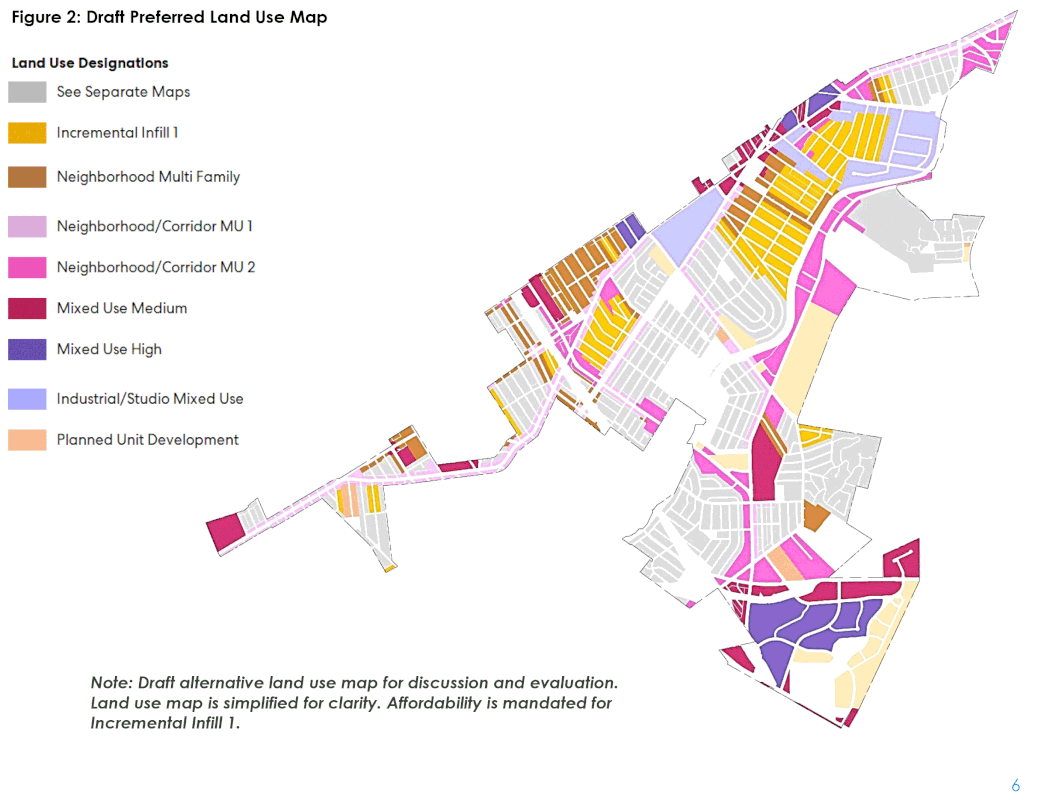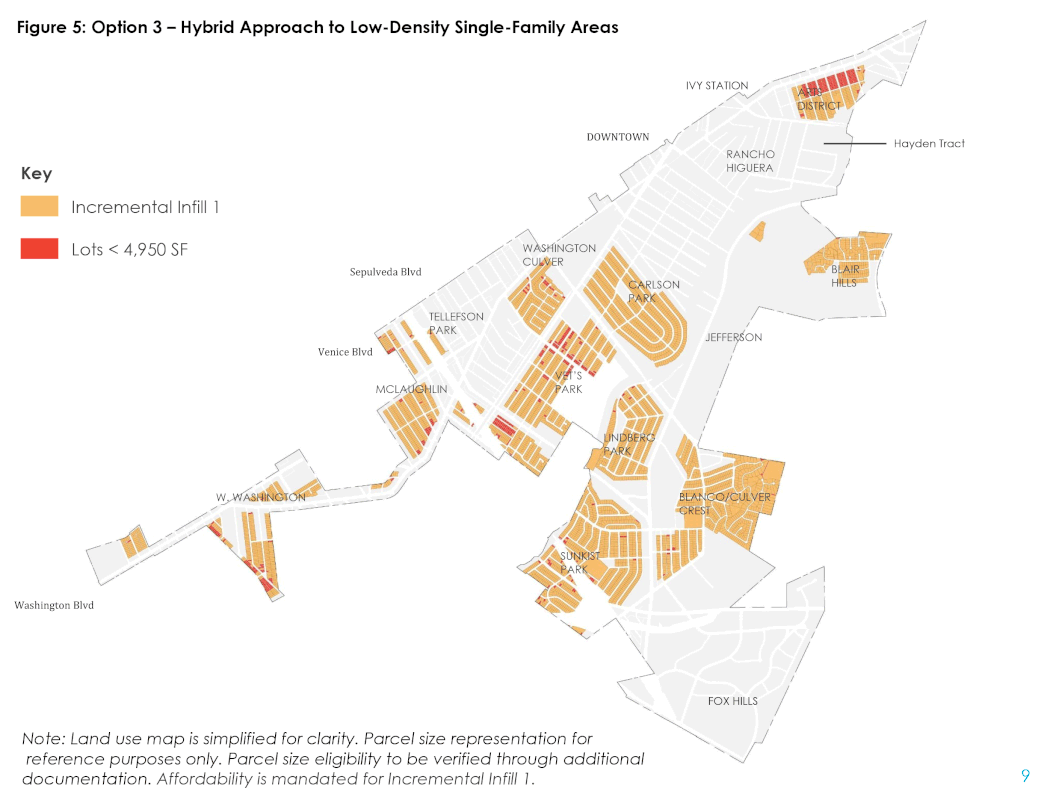History. As we know it.
What happened:
On Monday, June 28 at the specially-noticed joint Planning Commission/City Council meeting, Mayor Alex Fisch, Vice-Mayor Daniel Lee, and Councilmember Yasmine-Imani McMorrin made it clear that they wanted to allow up to 4 units (duplexes, triplexes, and quadplexes) to be built on single-family lots throughout Culver City. Councilmembers Göran Eriksson and Albert Vera disagreed.
What does this mean? It means that despite public opposition, the Council majority pushed ahead with their desire to upzone or allow up to 4 units to be built on every lot over 4,950 square feet. They told the General Plan Update team to dive into a month’s long study with the stated desire to ultimately result in the abolishment of single-family home zoning. If you're following along in detail, they chose "Option #3."
The intent of the study is to deliver a certain result. They are calling this a "study," but it's a study to figure out HOW to upzone. It is NOT a study to figure out IF the city should upzone.
Our neighbors in current R2 neighborhoods are not exempt. They too will be upzoned. At the moment, R2 lots can have a duplex, an ADU, and a Jr. ADU. If Culver City is upzoned according to the words spoken by three council members, R2 can also change forever. Cute older R2 duplexes can be torn down to make way for large quadplexes.
The council majority claims that the only way to create a “fair and equitable” city is to upzone. They purport that this will solve the lack of housing and affordable housing issues. They claim that the mere existence of single-family homes unfairly “segregates” these neighborhoods from the necessity of taking on the shared burden of creating additional housing. They stated that Culver City should provide housing for anyone who wants to live here.
Their theory amounts to none other than “trickle-down” housing, which guesses that increased numbers of units will magically decrease overall rent and home prices. This is “build it and they can afford it” magical thinking. Their arguments are unproven and filled with holes. Not a single council member is a professional housing expert or city planner. They did not campaign on eliminating R1 zoning. They refused to allow an alternate study based on current (post-pandemic) conditions in addition to the study they did approve. They pressed on with their untested and experimental political and philosophical positions.
We firmly believe that affordable housing, attention to the actual interests of the community, along with complete and adequate notice of major decisions should be what a city government focuses on. There are many creative solutions to providing more affordable housing in Culver City that do not involve eliminating R1 zoning.
If this moves forward:
This rushed council-mandated push to eliminate R-1/Single-family zoning will be incorporated into the General Plan housing element and submitted to the state this autumn. The dominos will start to fall. It will set up a self-inflicted requirement that the city follows the path to abolish single-family home zoning. This will lead to the permitting of untold numbers of million-dollar-plus townhomes in the formerly single-family home neighborhoods. The three-plexes and four-plexes that will be built throughout Culver City will only benefit the developers and speculators and will do nothing to help solve the affordability crisis. It will do nothing to help the unhoused or help current income-burdened families in need. It will do nothing to uplift our BIPOC community and support the antiracist policies that our community has pledged to vigorously pursue.
Our community loses and only the developers and speculators win.
On Monday, June 28 at the specially-noticed joint Planning Commission/City Council meeting, Mayor Alex Fisch, Vice-Mayor Daniel Lee, and Councilmember Yasmine-Imani McMorrin made it clear that they wanted to allow up to 4 units (duplexes, triplexes, and quadplexes) to be built on single-family lots throughout Culver City. Councilmembers Göran Eriksson and Albert Vera disagreed.
What does this mean? It means that despite public opposition, the Council majority pushed ahead with their desire to upzone or allow up to 4 units to be built on every lot over 4,950 square feet. They told the General Plan Update team to dive into a month’s long study with the stated desire to ultimately result in the abolishment of single-family home zoning. If you're following along in detail, they chose "Option #3."
The intent of the study is to deliver a certain result. They are calling this a "study," but it's a study to figure out HOW to upzone. It is NOT a study to figure out IF the city should upzone.
Our neighbors in current R2 neighborhoods are not exempt. They too will be upzoned. At the moment, R2 lots can have a duplex, an ADU, and a Jr. ADU. If Culver City is upzoned according to the words spoken by three council members, R2 can also change forever. Cute older R2 duplexes can be torn down to make way for large quadplexes.
The council majority claims that the only way to create a “fair and equitable” city is to upzone. They purport that this will solve the lack of housing and affordable housing issues. They claim that the mere existence of single-family homes unfairly “segregates” these neighborhoods from the necessity of taking on the shared burden of creating additional housing. They stated that Culver City should provide housing for anyone who wants to live here.
Their theory amounts to none other than “trickle-down” housing, which guesses that increased numbers of units will magically decrease overall rent and home prices. This is “build it and they can afford it” magical thinking. Their arguments are unproven and filled with holes. Not a single council member is a professional housing expert or city planner. They did not campaign on eliminating R1 zoning. They refused to allow an alternate study based on current (post-pandemic) conditions in addition to the study they did approve. They pressed on with their untested and experimental political and philosophical positions.
We firmly believe that affordable housing, attention to the actual interests of the community, along with complete and adequate notice of major decisions should be what a city government focuses on. There are many creative solutions to providing more affordable housing in Culver City that do not involve eliminating R1 zoning.
If this moves forward:
This rushed council-mandated push to eliminate R-1/Single-family zoning will be incorporated into the General Plan housing element and submitted to the state this autumn. The dominos will start to fall. It will set up a self-inflicted requirement that the city follows the path to abolish single-family home zoning. This will lead to the permitting of untold numbers of million-dollar-plus townhomes in the formerly single-family home neighborhoods. The three-plexes and four-plexes that will be built throughout Culver City will only benefit the developers and speculators and will do nothing to help solve the affordability crisis. It will do nothing to help the unhoused or help current income-burdened families in need. It will do nothing to uplift our BIPOC community and support the antiracist policies that our community has pledged to vigorously pursue.
Our community loses and only the developers and speculators win.


